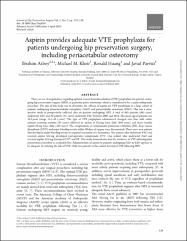| dc.contributor.author | Azboy, İbrahim | |
| dc.contributor.author | Kheir, Michael M. | |
| dc.contributor.author | Huang, Ronald | |
| dc.contributor.author | Parvizi, Javad | |
| dc.date.accessioned | 10.07.201910:49:13 | |
| dc.date.accessioned | 2019-07-10T19:58:15Z | |
| dc.date.available | 10.07.201910:49:13 | |
| dc.date.available | 2019-07-10T19:58:15Z | |
| dc.date.issued | 2018 | en_US |
| dc.identifier.citation | Azboy, İ., Kheir, M., Huang, R. ve Parvizi, J. (2018). Aspirin provides adequate vte prophylaxis for patients undergoing hip preservation surgery, including periacetabular osteotomy. Journal of Hip Preservation Surgery, 5(2), 125-130. https://dx.doi.org/10.1093/jhps/hny010 | en_US |
| dc.identifier.issn | 2054-8397 | |
| dc.identifier.uri | https://dx.doi.org/10.1093/jhps/hny010 | |
| dc.identifier.uri | https://hdl.handle.net/20.500.12511/3137 | |
| dc.description | WOS: 000449501200005 | en_US |
| dc.description | PubMed ID: 29876128 | en_US |
| dc.description.abstract | There are no dear guidelines regarding optimal venous thromboembolism (VTE) prophylaxis for patients undergoing hip preservation surgery (HPS), in particular pelvic osteotomy, which is considered to be a major orthopaedic procedure. The aim of this study was to determine the efficacy of aspirin for VTE prophylaxis in a large cohort of patients undergoing femoroacetabular osteoplasty (FAO) and periacetabular osteotomy (PAO). This was a retrospective study of prospectively collected data on patients undergoing HPS. A total of 603 patients (643 cases) underwent FAO and 80 patients (87 cases) underwent PAO between 2003 and 2016. The mean age of patients was 34.3 years (range 14.3-68.1 years). The type of VTE prophylaxis administered changed over time with earlier patients receiving warfarin (44 cases), followed by aspirin at 325 mg twice daily (448 cases), and most recently aspirin 81 mg twice daily (238 cases). The complications of symptomatic pulmonary embolism (PE), deep venous thrombosis (DVT) and major bleeding events within 90 days of surgery were documented. There were zero patients that developed major bleeding events or required evacuation of a hematoma. One patient who underwent FAO and received aspirin 325 mg, developed post-operative symptomatic DVT. One patient who underwent PAO and received aspirin 325 mg developed DVT and PE. This study demonstrates that the incidence of VTE following joint preservation procedure is acceptably low. Administration of aspirin to patients undergoing FAO or PAO appears to be adequate in reducing the risk of VTE. Only two patients in this cohort developed VTE following HPS. | en_US |
| dc.language.iso | eng | en_US |
| dc.publisher | Oxford University Press | en_US |
| dc.rights | info:eu-repo/semantics/openAccess | en_US |
| dc.subject | Direct Anterior Approach | en_US |
| dc.subject | Deep-Vein Thrombosis | en_US |
| dc.subject | Knee Arthroplasty | en_US |
| dc.subject | Venous Thromboembolism | en_US |
| dc.subject | Prevention | en_US |
| dc.subject | Thromboprophylaxis | en_US |
| dc.subject | Events | en_US |
| dc.title | Aspirin provides adequate vte prophylaxis for patients undergoing hip preservation surgery, including periacetabular osteotomy | en_US |
| dc.type | article | en_US |
| dc.relation.ispartof | Journal of Hip Preservation Surgery | en_US |
| dc.department | İstanbul Medipol Üniversitesi, Tıp Fakültesi, Cerrahi Tıp Bilimleri Bölümü, Ortopedi ve Travmatoloji Ana Bilim Dalı | en_US |
| dc.authorid | 0000-0003-0926-3029 | en_US |
| dc.identifier.volume | 5 | en_US |
| dc.identifier.issue | 2 | en_US |
| dc.identifier.startpage | 125 | en_US |
| dc.identifier.endpage | 130 | en_US |
| dc.relation.publicationcategory | Makale - Uluslararası Hakemli Dergi - Kurum Öğretim Elemanı | en_US |
| dc.identifier.doi | 10.1093/jhps/hny010 | en_US |
| dc.identifier.wosquality | Q3 | en_US |


















